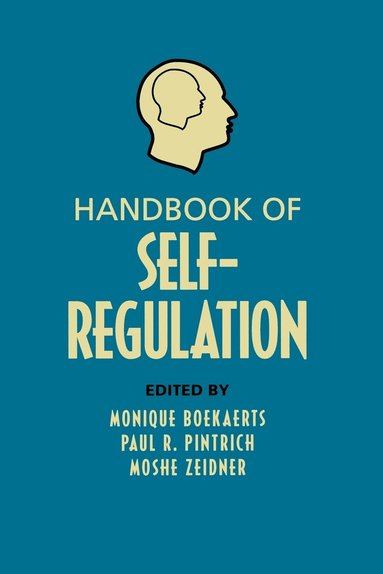
- Format
- Häftad (Paperback)
- Språk
- Engelska
- Antal sidor
- 816
- Utgivningsdatum
- 2005-08-01
- Upplaga
- illustrated ed
- Förlag
- Academic Press
- Medarbetare
- Pintrich, Paul R / Zeidner, Moshe
- Illustratör/Fotograf
- illustrations
- Illustrationer
- illustrations
- Dimensioner
- 227 x 157 x 41 mm
- Vikt
- Antal komponenter
- 1
- Komponenter
- 23:B&W 6 x 9 in or 229 x 152 mm Perfect Bound on White w/Gloss Lam
- ISBN
- 9780123695192
- 1044 g
Handbook of Self-Regulation
- Skickas från oss inom 10-15 vardagar.
- Fri frakt över 249 kr för privatkunder i Sverige.
Passar bra ihop
De som köpt den här boken har ofta också köpt Bad Therapy av Abigail Shrier (inbunden).
Köp båda 2 för 1145 krKundrecensioner
Fler böcker av Monique Boekaerts
-
Instructional Psychology
Lieven Verschaffel, Filip Dochy, Monique Boekaerts, Stella Vosniadou
To celebrate Erik De Cortes scientific career in the international scientific field of instructional psychology, high profile researchers and scholars were invited by the editors to write an essay on the past, present, and future of the subdomain ...
Recensioner i media
"the definitive psychology text on willpower" --John Cloud, Time Magazine June 12 2006
Övrig information
Monique Boekaerts is Professor of Educational Psychology at Leiden University (The Netherlands) and chairs the Research Committee of the Faculty of Social Sciences. As a principle investigator, she is supervising a national school reform program in vocational schools. Her main field of interest is self-regulated learning with a focus on motivation, volitional control, coping with stress, and soliciting social support. President-elect of the European Association of Learning and Instruction and President of the Educational and Institutional Psychology division of the International Association of Applied Psychology, she has written over 100 scientific articles and book chapters. She serves as associate editor of Learning and Instruction and as reviewer for several international and European journals. Moshe Zeidner is Professor of Educational and Social Psychology at the University of Haifa, Israel. He serves as Director of the Center for the Interdisciplinary Research on Emotions and Scientific Director of the Laboratory for Cross-Cultural Research in Personality and Individual Differences. His main field of interest is personality and individual differences research, with particular concern for anxiety, stress and coping, and the personality-intelligence interface. He is series editor for two series: Human Emotions, and Human Exceptionality. He also serves as Associate Editor of Anxiety, Stress, and Coping: An International Journal and a reviewer for a number of APA journals. He is the author of over 100 scientific papers and chapters and his recent books include: Test Anxiety: The State of the Art, (1998), Handbook of Coping, Stress, Anxiety, and Coping in Academic Settings, and, International Handbook of Personality and Intelligence.
Innehållsförteckning
* Foreword* About the Editors*1: Self-Regulation: An Introductory Overview* Part I: General Theories and Models of Self-Regulation *2: Attaining Self-Regulation: A Social Cognitive Perspective * I INTRODUCTION* II THE STRUCTURE OF SELF-REGULATORY SYSTEMS* III SOCIAL AND ENVIRONMENTAL INFLUENCES ON SELF-REGULATION* IV DYSFUNCTIONS IN SELF-REGULATION* V DEVELOPMENT OF SELF-REGULATORY SKILL* VI FUTURE RESEARCH DIRECTIONS* VII A CONCLUDING COMMENT* ACKNOWLEDGMENT*3: On the Structure of Behavioral Self-Regulation * I BEHAVIOR IS GOAL DIRECTED AND FEEDBACK CONTROLLED* II HIERARCHICALITY AMONG GOALS* III FEEDBACK CONTROL AND CREATION OF AFFECT* IV CONFIDENCE AND DOUBT, PERSISTENCE AND GIVING UP* V DYNAMIC SYSTEMS AND HUMAN BEHAVIOR* VI CATASTROPHE THEORY* VII CONCLUDING COMMENT* ACKNOWLEDGMENT*4: Aspects of Goal Networks: Implications for Self-Regulation * I A STRUCTURAL ANALYSIS OF GOAL NETWORKS* II SELF-REGULATORY CONSEQUENCES OF GOAL NETWORK STRUCTURE* III INDIVIDUAL DIFFERENCES IN THE STRUCTURE OF GOALS AND MEANS* IV COMPARISON TO OTHER PERSPECTIVES ON GOAL NETWORKS* V FUTURE DIRECTIONS: INTERPERSONAL GOALS* VI CONCLUSION*5: A Functional-Design Approach to Motivation and Self-Regulation: The Dynamics of Personality Systems Interactions * I INTRODUCTION* II DYNAMIC CONCEPTS IN CLASSICAL THEORIES OF MOTIVATION* III ARISTOTLE'S DYNAMIC CONCEPTS* IV PERSONALITY SYSTEMS INTERACTION THEORY* V BACK TO THE FUTURE: FROM CONTENTS TO MECHANISMS* VI CONCLUSION* ACKNOWLEDGMENT*6: Personality, Self-Regulation, and Adaptation: A Cognitive-Social Framework * I FRAMEWORKS FOR PERSONALITY AND SELF-REGULATION RESEARCH* II SELF-REGULATION, TRAITS, AND COGNITIVE STRESS PROCESSES* III PERSONALITY AND SELF-REGULATION OF REACTIONS TO LIFE STRESS* IV PERSONALITY AND SELF-REGULATION IN PERFORMANCE ENVIRONMENTS* V AGGRESSIVE BEHAVIOR* VI CONCLUSIONS*7: Organization and Development of Self-Understanding and Self-Regulation: Toward a General Theory * I INTRODUCTION* II THE ARCHITECTURE OF SELF-AWARE AND SELF-REGULATED SYSTEMS* III DEVELOPMENT OF SELF-UNDERSTANDING AND SELF-REGULATION* IV EXPLAINING THE DEVELOPMENT OF SELF-UNDERSTANDING AND SELF-REGULATION* V CONCLUSIONS*8: The Role of Intention in Self-Regulation: Toward Intentional Systemic Mindfulness * I SYSTEMS THEORY, SELF-REGULATION, AND MINDFULNESS* II SELF-REGULATION* III SELF-REGULATION TECHNIQUES AND POTENTIAL LIMITATIONS* IV PSYCHOPHYSIOLOGICAL RESEARCH ON SELF-REGULATION - PHYSIOLOGY AND ENERGY* V ELABORATION OF AN EXPANDED SELF-REGULATION MODEL: INTENTION* VI INTENTION* VII INTENTIONAL SYSTEMIC MINDFULNESS: MINDFULNESS QUALITIES AND SYSTEMIC PERSPECTIVES* VIII APPLICATIONS OF INTENTIONAL SYSTEMIC MINDFULNESS TO SELF-REGULATION TECHNIQUES* IX CONNECTEDNESS AND INTERCONNECTEDNESS* X GENERAL PRINCIPLES OF INTENTIONAL SYSTEMIC MINDFULNESS INTERVENTIONS* XI FACILITATING INTENTION SYSTEMIC MINDFULNESS* XII DIRECTIONS FOR FUTURE RESEARCH* XIII IMPLICATIONS FOR HEALTH AND MEDICINE* XIV SUMMARY* ACKNOWLEDGMENTS*9: Communal Aspects of Self-Regulation * I INTRODUCTION* II COPING AS SELF-REGULATION* III SUMMARY AND CONCLUSION* ACKNOWLEDGMENT* Part II: Domain-Specific Models and Research on Self-Regulation *10: Self-Regulation in Organizational Settings: A Tale of two Paradigms * I INTRODUCTION* II DEFINITIONS* III TWO PARADIGMS* IV THE PARADIGMS IN INDUSTRIAL- ORGANIZATIONAL PSYCHOLOGICAL THEORIES OF SELF-REGULATION* V MERGING THE PARADIGMS* VI CONCLUSION*11: Self-Regulation and Health Behavior: The Health Behavior Goal Model * I INTRODUCTION* II CURRENT HEALTH BEHAVIOR MODELS AND SELF-REGULATION* III SELF-REGULATION AND THE PERSONAL GOAL STRUCTURE* IV GOAL ALIGNMENT, GOAL CONFLICT, AND GOAL BALANCE* V GOAL SETTING AND GOAL ORIENTATION* VI GOALS, BELIEFS, AND EMOTIONS* VII THE SELF-REGULATION PROCESS* VIII THE HEALTH BEHAVIOR GOAL MODEL* IX CONCLUSION AND DIRECTIONS FOR FUTURE RESEARCH* ACKNOWLEDGMENT*12: Regulation, Self-Regulation, and Construction of the Self in the Maintenance of Physical He


